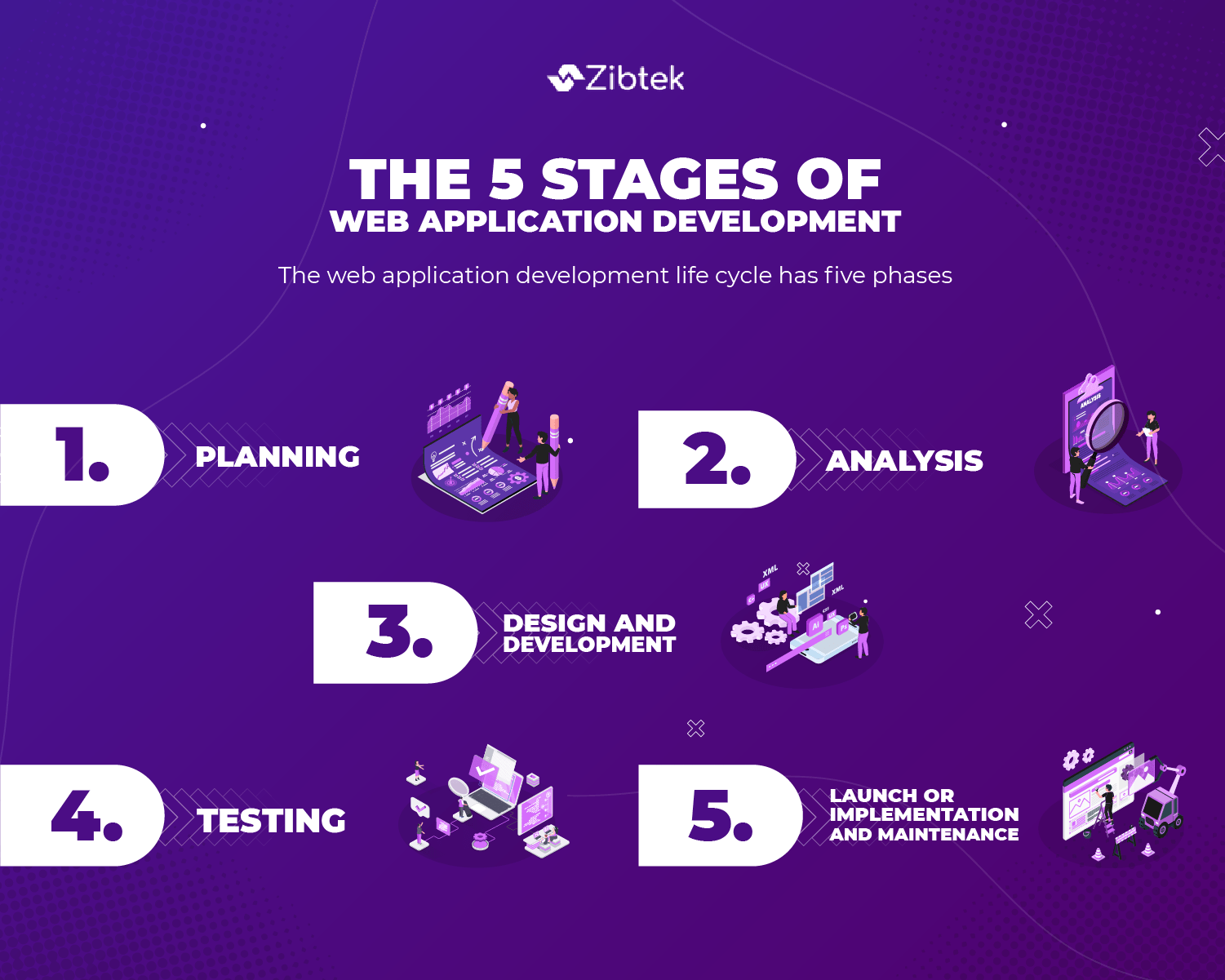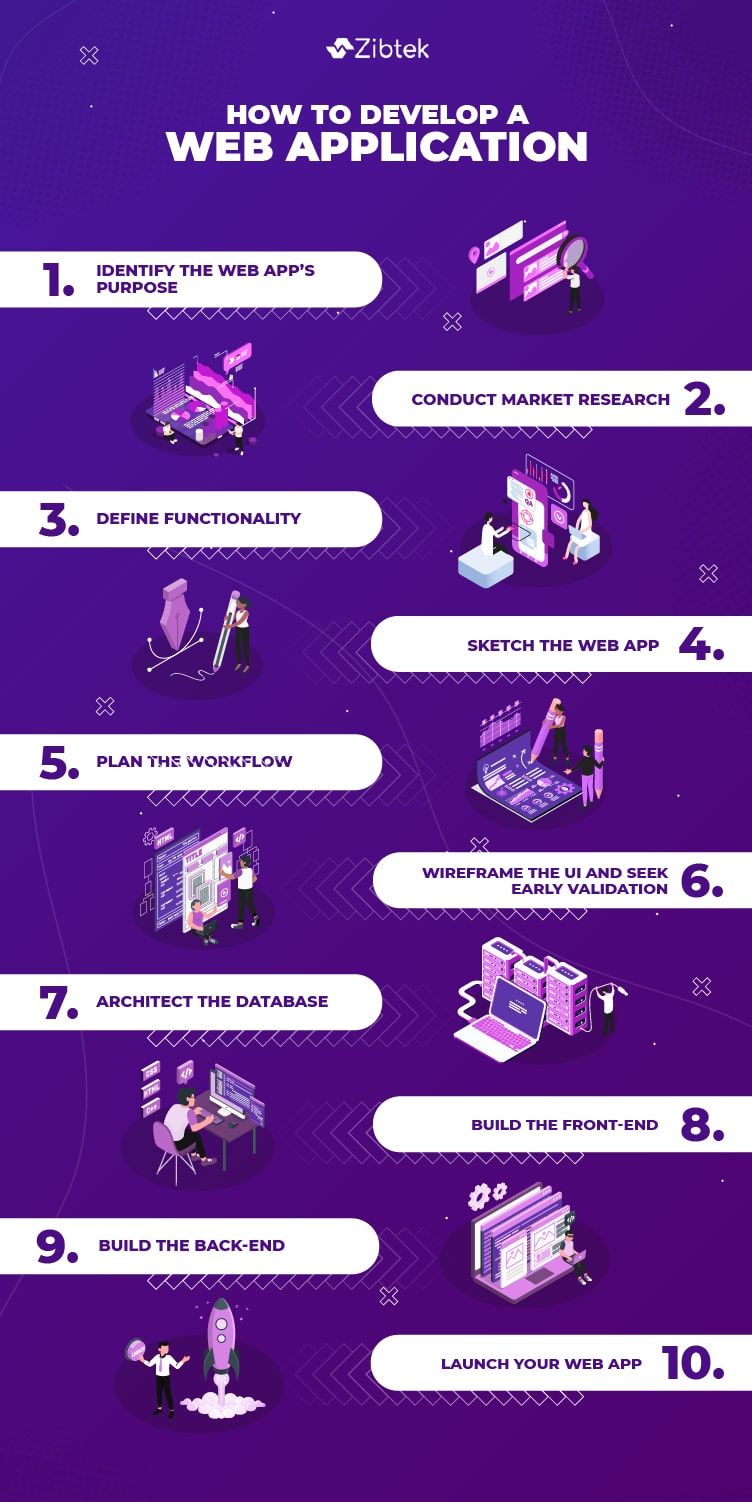Learning how to develop a web application isn’t as difficult as you might think. When the idea of web applications was introduced back in 1999, each app had to be separately installed on each user’s personal computer. Today, web applications are supported by various web browsers and can work on any operating system. But what’s remained the same is how beneficial they are for those who use them.
As web apps have become an integral part of life, they often go unnoticed unless, of course, they’re poorly developed. An experienced web app development consultancy like Zibtek can work with you to develop intuitive, custom web applications that simply your day-to-day operations and your customers’ lives.
The 5 Stages of Web Application Development
The web application development life cycle has five phases:
- Planning
- Analysis
- Design and Development
- Testing
- Launch or implementation and maintenance.
Following this methodology ensures project consistency and completeness and an end product that provides the solution you’re looking for.

How To Develop a Web Application
Calling, messaging, gaming, checking bank balances, and ordering a pizza. What would life be without web apps? Businesses, too, rely on web apps for everything from marketing their business to conducting workplace drug and alcohol screenings.
So if you're wondering how to develop a web application, it's important to consider what your app is going to be used for once it's developed. While each web app serves a unique purpose, the development process remains consistent across the board.
Step 1: Identify the web app’s purpose
The best web apps spring from real-life problems that need better solutions. Not every web application needs to be a breakthrough phenomenon. But your web app should offer a significant, measurable improvement over other apps. Ask yourself:
- What will people use this app for?
- How will it make life easier for them?
- What solutions does it offer that other apps don’t?
Step 2: Conduct market research
It’s easy to get caught up in the design and development of the actual app, but if you hope to implement a successful road map, it’s essential to frequently check in with actual users. In the early stages, you’ll need to focus on higher-level problems in order to fully understand all the challenges the end-user faces. As app development progresses, challenges become more granular and narrower. For instance, is a lack of documentation making it more difficult to adopt features? Is an API deficiency reducing efficiency?
Step 3: Define functionality
The better you can define what constitutes good functionality, the more users will prefer and use your web application. For example, if you want to develop a web app that streamlines the customer’s buying experience, you might want to focus on building better comparison and checkout experiences. The goal is to design an app that leaves a positive impression with the user.
Step 4: Sketch the web app
For this step, some people use paper and pencil. Others like web apps like Google Docs. Whichever you prefer, now’s the time to map out your application’s layout which includes text, image, and button placement, as well as other interactive components. Your design should be orderly and flow intuitively. Be sure to refer back to your market research to ensure you’re answering users’ specific desires. If you prefer to find help with the design aspect, here's an excellent source for you.
Step 5: Plan the workflow
As part of the planning stage, the development team prepares an action plan, taking into account the time and specialists needed to implement the project. An initial meeting is held to discuss everything from further work to communication rules and project management. Zibtek’s practical Agile approach relies on sprints, which are small, targeted allotments of development time that allow our engineers to solve problems more collaboratively. Sprints are ideal for more easily incorporating new ideas, improving project predictability, and delivering a superior product.

Step 6: Wireframe the UI and seek early validation
A visually compelling user experience is critical to web app adoption. Think of wireframes as sketches that tell you exactly how your web application’s pages will look. It’s often best to build a basic prototype to start and then build on it as testing and feedback are conducted. Alpha and beta testing of your prototype help improve your web app, make it more user-friendly, and give you a strong foundation for a more successful development process.
Step 7: Architect the database
A web app’s architecture simply describes the interactions between applications, databases, and middleware systems on the web. Database architecture uses various programming languages to design a particular type of application. Which one is used for your app depends on, among other things, time, budget, and functionality considerations. Most web apps use SQL or document databases.
Step 8: Build the front-end
The front-end of your web app is its visual elements, defining what users see and interact with. Developers use web technologies like HTML, CSS, and JavaScript to create visually appealing applications that users find easy to read and navigate.
Step 9: Build the back-end
Back-end development is the server-side logic that powers your app from “behind the scenes.” It includes all the code necessary for build out the database, server, and application.
Step 10: Launch your web app
Once you choose a hosting platform that provides exceptional page load speeds and uptimes, your web app is ready for launch!
As an essential tool for businesses large and small, web apps offer improved efficiency, 24/7 accessibility, and higher security levels. At Zibtek, we develop and build custom web applications more quickly and at a lower cost than you might have thought possible. To learn more or to talk with one of our experts, get in touch with us today.
What are the steps to build a web application?
First is to conceptualise the product. Then, second, is the discovery / design phase. Third is the development phase. Fourth, you launch the application. And then fifth and finally is ongoing maintenance and support.
How to develop a web application?
In order to build a web application, you must have a clear idea of the goals for the application. Once the goals of the application are clearly defined, you will now want to hire or contract a development team to put together a technical plan to build the application in the most efficient way to accomplish the goals you have outlined. It is important that you are always clear on the goals of the application and allow the development team to determine how the application will be built.
What is the first stage of web application development?
The first stage of web application development is discovery. In discovery, the product team will work with the development team to outline the deliverables of the project, decide a technology stack, create wireframes / designs, define the architecture of the application, and finalize a timeline of completion with milestones.

